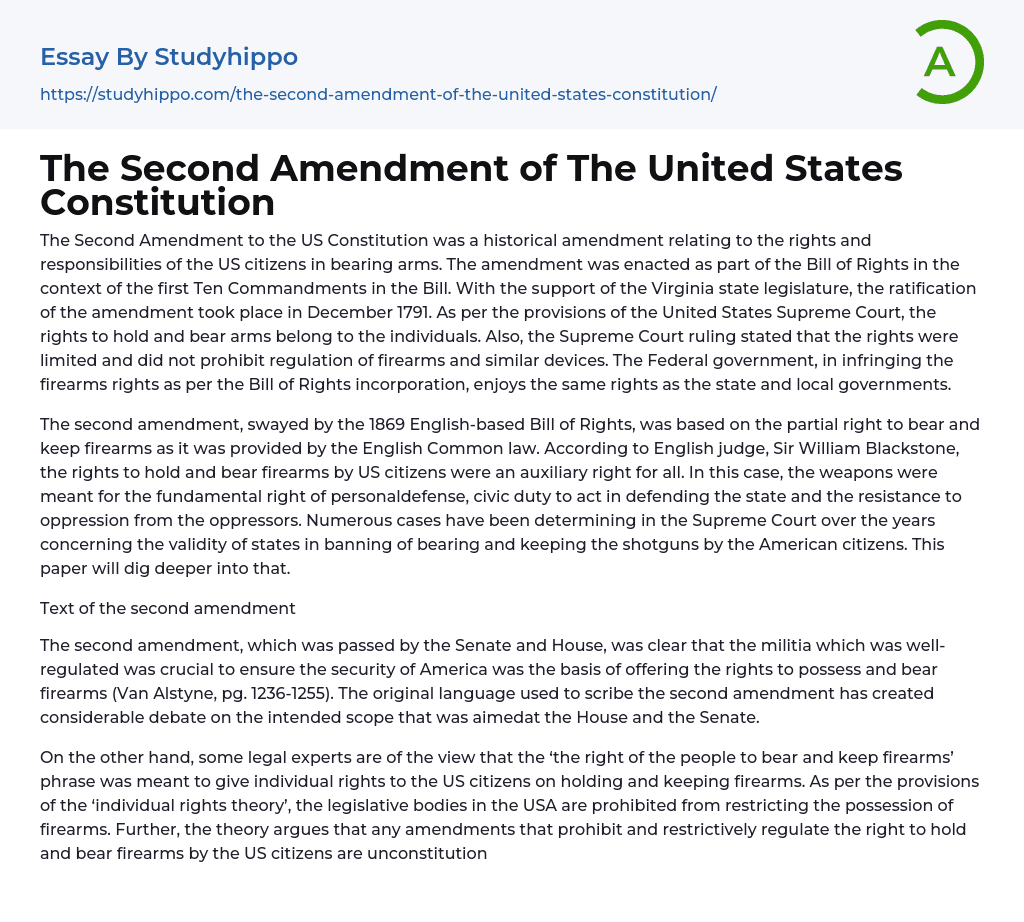

The Second Amendment of The United States Constitution Essay Example
The Second Amendment to the US Constitution was a historical amendment relating to the rights and responsibilities of the US citizens in bearing arms. The amendment was enacted as part of the Bill of Rights in the context of the first Ten Commandments in the Bill. With the support of the Virginia state legislature, the ratification of the amendment took place in December 1791. As per the provisions of the United States Supreme Court, the rights to hold and bear arms belong to the individuals. Also, the Supreme Court ruling stated that the rights were limited and did not prohibit regulation of firearms and similar devices. The Federal government, in infringing the firearms rights as per the Bill of Rights incorporation, enjoys the same rights as the state and local governments.
The second amendment, swayed by the 1
...869 English-based Bill of Rights, was based on the partial right to bear and keep firearms as it was provided by the English Common law. According to English judge, Sir William Blackstone, the rights to hold and bear firearms by US citizens were an auxiliary right for all. In this case, the weapons were meant for the fundamental right of personaldefense, civic duty to act in defending the state and the resistance to oppression from the oppressors. Numerous cases have been determining in the Supreme Court over the years concerning the validity of states in banning of bearing and keeping the shotguns by the American citizens. This paper will dig deeper into that.
Text of the second amendment
The second amendment, which was passed by the Senate and House, was clear that the militia which was well-regulated was crucia
to ensure the security of America was the basis of offering the rights to possess and bear firearms (Van Alstyne, pg.
1236-1255). The original language used to scribe the second amendment has created considerable debate on the intended scope that was aimedat the House and the Senate. On the other hand, some legal experts are of the view that the ‘the right of the people to bear and keep firearms’ phrase was meant to give individual rights to the US citizens on holding and keeping firearms. As per the provisions of the ‘individual rights theory’, the legislative bodies in the USA are prohibited from restricting the possession of firearms.
Further, the theory argues that any amendments that prohibit and restrictively regulate the right to hold and bear firearms by the US citizens are unconstitutional. Other scholars have asserted that the prefatory language in the Amendment, ‘a well-regulated militia’ meant that the Congress was restricted by the framers from legislating on the right to self-defense for the state. In dealing with US citizens as whole on the right to bear and keep firearms, some scholars have termed the second amendment as ‘the collective choice theory’. The theory asserts that in the second amendment, the second amendment argues that citizens have an individual right to possess firearms.
However, the Federal, state and legislative bodies without violating the constitutional right, can regulate guns. In 1939, the collective choice approach was applied US principal Court adopted in the case of United States v. Miller. The court determined that the Congress could regulate a shot-gun and this provided that the sawed-off shotgun had been shifted in the trade between the states. In the
case, the judge of the Supreme Court in his verdict said that under the National Firearms Act of 1934, there was not enough evidence to indicate that the short gun ‘had a sensible relationship to the efficacy of the well-controlled militia as it was provided for in the second amendment. Further, the judge asserted that all the framers were inclusive in the second amendment ensuring the effectiveness of the military.
In 2008, the Supreme Court reexamined the case in another instance of District of Columbia v. Heller. This was 70 years later after the US v. Miller case. Heller, the litigant, in this case, had tested the legality of the handgun ban in Washington DC in a 32-year old statute.
The law was seen by many as overly strict in the nation (Sunstein, 246). Detailing the antiquity of the second amendment tradition, the court proclaimed that individual rights had been established in the USA. In a 5-4 ruling, the court further indicated that citizens had the rights to possess firearms from the traditional second amendment meant to defend the state using the arms. The Washington handgun ban was henceforth struck down by the Court. The majority in the Court verdict were of the view that law-abiding Americans might possess firearms for use in the law-abiding purposes. In its dicta, the court found out that regulations of similar weaponry could not have been employed by the American citizens in the law-abiding purposes.
The Supreme Courtwas, therefore, able to revitalize the second amendment through the United States v. Heller case. In 2010, the seconded amendment was further strengthened by the Supreme Court through the McDonald V. City of Chicago case.
The plaintiff, in this instance, was an American, McDonald who was questioning the constitutionality of handgun ban in Chicago.
Through a 5-4 court decision, it was held by the court that the second amendment was still applicable through the doctrine of incorporation. To sum up, several questions remain unanswered on the regulatory control of firearms by the second amendment. Also, the Supreme Court has not provided clarity on whether the lower courts are under the jurisdiction of applying dicta regarding the permissible restrictions. On the other hand, the level of scrutiny that should be enforced by lower and the subsequent courts in analyzing the statutes has not been corrected to avoid the infringement of the second amendment.
Work Cited
- Sunstein, Cass R. "Second Amendment Minimalism: Heller as Griswold." Harv. L. Rev. 122 (2008): 246.
- Van Alstyne, William. "The second amendment and the personal right to arms." Duke Law Journal 43.6 (1994): 1236-1255.



